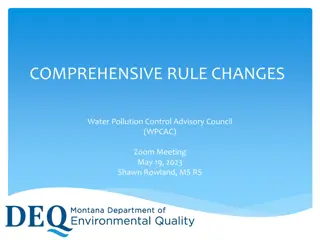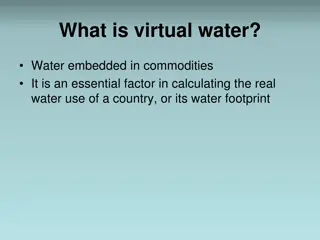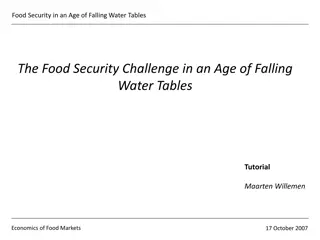Understanding the New Rules in Water Polo: Key Changes and Implications
Explore the latest rule changes in water polo, including the transition from the 2m area to the Goal Area, penalties, tactical fouls, and players going underwater. Discover what the rules say about player positioning, fouls, and goal areas, along with visual representations illustrating the changes and key philosophies to remember when implementing the new rules.
Uploaded on Oct 05, 2024 | 0 Views
Download Presentation

Please find below an Image/Link to download the presentation.
The content on the website is provided AS IS for your information and personal use only. It may not be sold, licensed, or shared on other websites without obtaining consent from the author. Download presentation by click this link. If you encounter any issues during the download, it is possible that the publisher has removed the file from their server.
E N D
Presentation Transcript
The Main Points - Change of the 2m area to the Goal Area (Rule 21.10). - Change to the awarding of and positioning for a Penalty (Rule 23.2). - Change to prevent Tactical Fouls (Rule 22.11). - Change to players going under the water (Rule 21.18).
What the Rules Say - It is an ordinary foul if an attacking player is within the goal area except when behind the line of the ball. - It shall not be an offence if a player is inside the 2-metre line but outside the goal area. - Any player who is behind the line of the ball can enter the goal area to receive the ball. - Any player inside the goal area who does not shoot but passes the ball backwards has to leave the goal area immediately to avoid being sanctioned under this rule.
Change of the 2m Rule How it Looks - Old 2m area gone changed to Goal Area - Goal Area is 2m either side of the posts and to the existing 2m line. - The 2m cone/marking will still exist. - The Goal Area (for Round 2) will be market with red fabric over the lane ropes to be highly visible. - In future rounds, the lane ropes will be changed to Red).
Philosophies to Remember Change of the 2m Rule - At this stage, we are treating the Goal Area just as a shortened 2m area. - Ergo, all the old rules regarding the 2m area apply. - The key to our decision making is where the ball is (and whether the player is in front of or behind the line of the ball when an action occurs. - Players cannot disappear (if they are inside the Goal Area and the ball moves quicker than they do). - Therefore we can t expect that we won t have tricky situations where the ball movement beats the player moving out of the Goal Area. - In these scenarios, in order for the ball to not be turned over, the players must be actively attempting to leave the Goal Area.
Reinforcements 2m Area - Treat the Goal Area like a smaller 2m Area - A player in the Goal Area of the opponent team can never be in front of the line of the ball at any time during the game. - When a player is inside the Goal Area, even without getting the ball, he/she has a big influence on the defense and can give very big advantage for the attacking team. - The foul must be called every time because no passive situation exists when the player is in the Goal Area. - If something doesn t look/feel right , referees will bring the player and the ball out of the goal area and restart play from there.
Weird Things that this 2m Rule Impacts - Ball last touched by GK (2m to Attack) still played as per old rules - Attacking players to take corner throw from side ball went out as close to the side of the pool as possible at the junction of the 2m cone. - Foul outside Goal Area, but ball drifts into Goal Area. - Play stopped, ball and player asked to move out of Goal Area play resumes. - Foul inside Goal Area, but ball drifts out of Goal Area. - Play resumes with the ball being played outside the Goal Area.
Penalty Situations What the Rules Now Say - When a defending player commits any foul within the 6-metre area if a goal would probably have resulted, the referee can delay whistling and wait to see if the attacking player scores a goal in the same action. - If the player does not score, the referee should sanction the penalty. - The referee may raise an arm indicating a possible penalty. - The signal that the referees will be using is the same gesture as signaling a foul outside 6m. - As per the below hand up, fingers closed, palm to the pool.
Penalty Situations Philosophies/Interpretations - Whilst there is no set time that the advantage is ruled to be played in, the rule states that the length of time is in the same action . There is no set time for the action to start/end. - If the player passes the ball (i.e. Cross-pass for score), the advantage is not transferred to the person they pass to. - Unless it is a clear cross-pass for a goal, the referees will award the penalty as the pass is being made. - Think of this advantage rule just like Rugby Union as soon as the advantage is given, no matter what happens (unless there is a try), the penalty is still awarded. - If the player fumbles the ball due to pressure, the penalty is still to be awarded. - If the player shoots the ball and it is saved, the penalty is still to be awarded. - If the player turns out to the side of the pool, the penalty is still to be given. The most important thing to remember here is that we are playing advantage. If the foul is committed and the referees play advantage, the only options here are that the goal is scored or the penalty is awarded.
Penalty Situations - Positioning What the Rules Say All players except the attacker who is going to take the penalty throw - shall leave the 6-metre area and shall be at least three metres from the player taking the throw. - - On the 6-metre line, on each side of the player taking the throw, one player of the defending team shall have the first right to take position. - The defending goalkeeper shall be positioned between the goal posts with no part of his body beyond the goal line at water level. - The referees can give one warning to the players or the goalkeeper to take up the correct position. If that person does not do so, the player or goalkeeper shall be excluded and shall reenter in accordance with WP 22.3. - This one warning is given to the goalkeeper every time a penalty is awarded. - i.e. It is NOT only one warning for the entirety of the game.
Penalty Situations What it Should Look Like
Tactical Fouls What the Rules Say - It is an exclusion foul for a defending player to commit a foul on any player of the team in possession of the ball with the intent to stop the flow of the attack, anywhere in the field of play. Examples: - Defending with 2 hands - Interfering with a Free Throw - Pushing the Ball away after a Foul - 2-Handed Fouls - Aggressive fouls to stop the ball moving quickly - Overly Physical fouls in extra-man. - These aren t new Referees were spoken to about implementing this in our pre- season meeting. This is just an emphasis point.
Penalty Situations Actions that (now) Constitute a Penalty - A team will be punished with a penalty throw if the coach, any team official, or player takes any action with intent to prevent a probable goal or to delay the game, including: - If a defending player deliberately throws the ball away before the attacking team can take a free throw. - If a defending player, after a free throw outside the 6-metre line, deliberately pushes the ball inside 6-metre line, to avoid a direct shot. Referees can use their discretion and still call exclusions in this scenario. i.e. If a ball is pushed inside 6m after a foul by the waves in the water created by a player retreating, it can still be an exclusion.
Players Going Under the Water What the Rules Say - Players are to be punished with an ordinary foul if they go under the water only to gain a positional advantage. - Referees will use the advantage principles. - If a player doesn t gain advantage, then the call will not be made. - We are not looking to ping instances where just a player s head barely goes underwater. - Referees only want to moderate if a player goes completely underwater and resurfaces.
Players Going Under the Water Examples - If a CF dives underwater and resurfaces on the other side of the CB and doesn t receive the ball no call no advantage. - If a CF Dives underwater and resurfaces on the other side of the CB and does receive the ball turnover (when the ball comes in). - If a CB dives under the water and gains an advantageous position and the ball doesn t come in play on. - If a CB dives under the water and gains an advantageous position and the ball does come in and (either) the CF can t get to the ball or loses the ball, a minor foul is to be awarded to the CF. The CB cannot be excluded for diving under only a minor foul can be given to the attack.
QUESTIONS? ash.kaesler@waterpoloqld.com.au 0452 549 418























